|
Originally Published by: Human Kinetics Most of the running game inside the tackle box is executed with the inside zone blocking scheme. When identifying the inside zone blocking schemes, terms such as power scoop and power slip are used on the backside of plays. Calls such as Jack Read, Jack Me, and Jack You are used on the front side of plays. (See chapter 7.) My philosophy of the inside zone scheme is to first take care of the down lineman. He is the level-1 player. It is okay to not get off to the linebacker if both linemen need to stay on the down lineman. This is called securing level 1. Too many players worry about getting to the line-backers. The end result is no one ends up blocking the level-1 defender. The inside zone play can be run out of the I-formation in which the fullback goes to the backside of the play as a cutoff blocker. The inside zone play is also run with the fullback leading to the play side as an extra blocker. When this is done, we use motion to put a wide receiver or H back in position to be the cut blocker backside. Out of the shotgun formation, we run a belly cutback dive play that uses the inside zone blocking scheme. This is a quarterback read play with an option back as well. My philosophy is to stretch the defense and make them run from sideline to sideline. Reverses, options, stretch plays, quick screens, and split screens can be run to achieve this movement of the defense. The offense can then come back hard inside with the inside zone running game. In this chapter, we look at blocking the inside zone versus four defensive fronts: odd, even, under front, and 4-3 stack. Inside Zone Versus An Odd Defense
The odd defensive front includes three down linemen and four linebackers. The tailback uses open crossover steps to get square to the line of scrimmage. He should aim at the guard's outside leg or the B gap. Versus an odd front, this play reads just like the stretch play. The tackle is the first read; the nose guard is the second read. In a 3-4 front, defensive linemen often perform a lot of movement with slants and angles on the defensive front. The running back has to read the defensive tackle for his first read. If the first read goes outside, the ball should go into the B gap. If the defensive tackle pinches inside, the ball should go to the C gap. If the tackle slants outside and the nose guard slants hard to the play side, the tailback should be ready to cut the ball back behind the nose guard. A mistake that running backs often make on this play is not pressing the line of scrimmage before they attempt to cut. If the running back cuts back too quickly, the offensive line, especially the backside guard and tackle, will not be in the right position. The offensive linemen execute their assignments:
If there is movement to the inside of the play-side tackle, the guard should end up in a Queen read until he can work off to the play-side linebacker (figure 9.2). The center and backside guard power scoop the nose guard. The offense needs to handle level 1 (all the down linemen) first before worrying about getting to the linebackers. Coaching Point: When facing an odd front with the outside linebacker in a 6 or 7 technique on the tight end (figure 9.3), the offense can make a call for a three-man game just like the outside stretch play. This play is blocked like a stretch play. The football should bounce outside on the pinch of the linebacker. The tight end and center should try to choke and squeeze the tackle and nose guard. The tackle and both guards should treat this as if it is the outside stretch play. Inside Zone Versus An Under Front
The offensive linemen execute their assignments: Tackle: tight reach block
Inside Zone Versus A 4-3 Defense This should be an effective play because of all the bubbles in the 4-3 defense. The backside 1-technique player must be controlled on this play The center should make a presnap read on the depth and alignment of the middle linebacker. The center should not overzone the linebacker or let him fall back inside on the play.
Tight end: tight reach block The zone and stretch plays should look as similar as possible on the first stretch step. Helmet placement is very important, especially on inside zone plays. The goal is to get the defender running hard to the outside, if possible. If the defenders are big run stoppers, the linemen need to be ready to drop their hips and knock them off the ball. At the very least, they need to hold the line of scrimmage. Against any inside pinch moves, the uncovered lineman should be ready to double with the covered lineman (figure 9.6). The uncovered lineman should aim his second step to a point behind the defender's inside foot. The uncovered lineman needs to be able to stop all penetration and maintain the line of scrimmage. If two offensive linemen must be used on a pinch defender, then they let the linebacker go free. Versus an under shift of the defensive front (figure 9.7), power combo blocks are a must. The covered offensive lineman must keep his play-side arm free and out of the block so he is able to come off if the linebacker attacks the line of scrimmage. If the Sam linebacker walks up on the line of scrimmage, the tackle and tight end must make an out call.
Another change-up that can be used is to fold the backside with the guard and center. The center works a back block to the V of the nose guard's neck. The guard executes a drop step and pulls to the play-side A gap to block the Mike linebacker (figure 9.9). Inside Zone Versus An Even Defense (40 Looks) Many defenses try to disguise the 40 even front and the 4-3 defense with cheat alignments of the middle linebacker. If the Mike linebacker commits to the play-side A gap, the offense should treat it like a 4-3 defense and go with it (figure 9.10a). If the Mike linebacker gets to a point backside at which the center has to go backside to block him, then the offense should treat it like an even front (figure 9.10b). The offensive linemen execute their assignments:
Tight end: block out on the strong safety, the number 4 read Tackle: man on man outside
The five offensive linemen zone step off the line of scrimmage and stay square to the line. By staying square, they will handle a lot of the movements that the defensive linemen are trying to execute. This is why it is so important for the center and guards to keep 18-inch splits and for the tackles to keep 2-foot splits. When the defender is in a shaded alignment on the center, the offense should treat it like the 4-3 defense. The only difference is that the Mike linebacker is much more in the play-side A gap (figure 9.12). With this being the case, the center may have to tag the nose guard and abort a little quicker than he would against a true Mike linebacker in order to get his man.
This is a great scheme as long as the 3-technique defender plays a 3 and does not pinch. Against an even front, the offense will usually get a lot of 3 techniques to 1 techniques and 1 techniques to 3 techniques. To counter this and take the pressure off the guard so he can come off the football, the guard's assignment should be to do a tight reach (figure 9.13) and not worry about the pinch.
If the backside tackle gets the fold call, he may have to take a stretch path to go get the backside linebacker deeper inside. This is especially true if the offense runs the inside dive from the shotgun. |
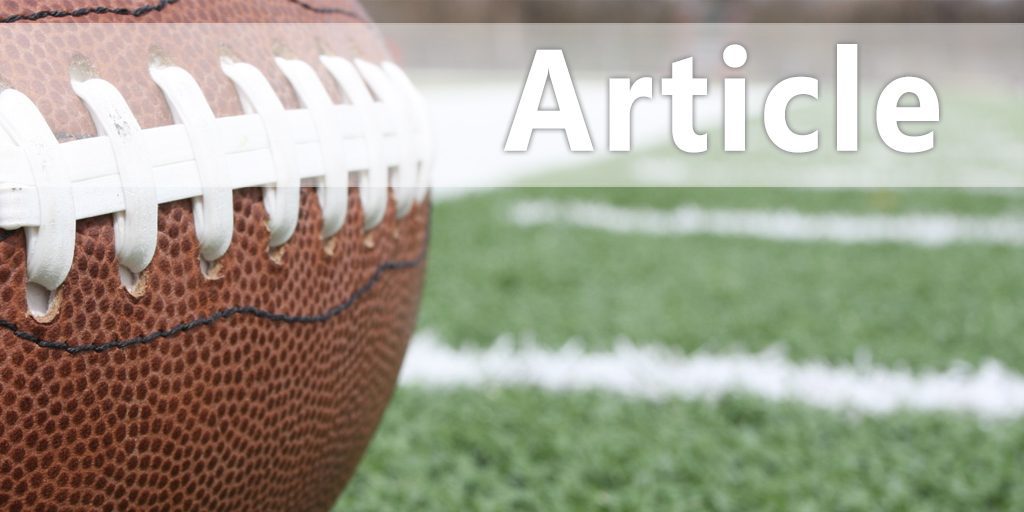


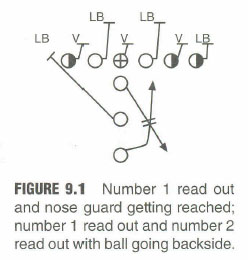 The tailback lines up 7 yards deep (figure 9.1). The fullback is used as a backside cut blocker off the backside edge. The backside tackle has to decide whether to use a 4 or 41 tackle alignment. In a 4 tackle alignment, the backside tackle aligns head up on the defensive tackle. In a 41 alignment, he aligns on the inside shade of the defensive tackle. These alignments require two different types of cutoff blocks.
The tailback lines up 7 yards deep (figure 9.1). The fullback is used as a backside cut blocker off the backside edge. The backside tackle has to decide whether to use a 4 or 41 tackle alignment. In a 4 tackle alignment, the backside tackle aligns head up on the defensive tackle. In a 41 alignment, he aligns on the inside shade of the defensive tackle. These alignments require two different types of cutoff blocks.
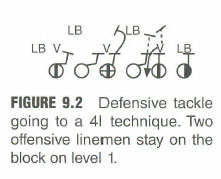 Tight end: tight reach block
Tight end: tight reach block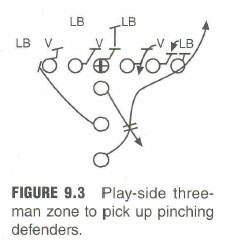 Offensive linemen should alert each other on the head-up technique. Knowing that there may be movement is advantageous. Linemen should handle the level-1 defenders first. They should not be in a hurry to get to level 2. If they aren't careful, both linemen will be in a hurry to get to the linebacker.
Offensive linemen should alert each other on the head-up technique. Knowing that there may be movement is advantageous. Linemen should handle the level-1 defenders first. They should not be in a hurry to get to level 2. If they aren't careful, both linemen will be in a hurry to get to the linebacker.
 Against the under front (figure 9.4), the offense must know what kind of nose guard they are up against. Is he quick? Can he run? Is he a big run stopper and gap player? Can the center handle him one on one or does he need help?
Against the under front (figure 9.4), the offense must know what kind of nose guard they are up against. Is he quick? Can he run? Is he a big run stopper and gap player? Can the center handle him one on one or does he need help?
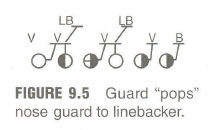 If the center calls for help from the play-side guard (figure 9.5), the guard should use the drive block technique with his outside foot over and up. The inside foot and inside arm should come straight off, and he should make contact with the same foot and shoulder. The guard should stay on the double team as long as possible. The play-side linebacker will read isolation and step right up to the guard. When the linebacker gets even with the guard, the guard comes off and blocks him. If there is a 1-technique or gap player, the guard doubles him out to the linebacker.
If the center calls for help from the play-side guard (figure 9.5), the guard should use the drive block technique with his outside foot over and up. The inside foot and inside arm should come straight off, and he should make contact with the same foot and shoulder. The guard should stay on the double team as long as possible. The play-side linebacker will read isolation and step right up to the guard. When the linebacker gets even with the guard, the guard comes off and blocks him. If there is a 1-technique or gap player, the guard doubles him out to the linebacker.
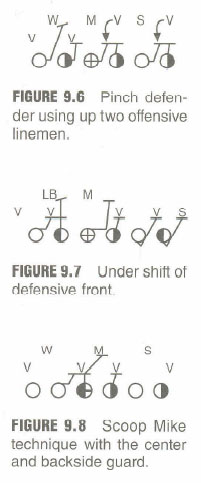 The offensive linemen execute their assignments:
The offensive linemen execute their assignments:
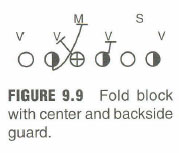 If the nose guard is aligned in a shaded position on the center (figure 9.8), he needs to stretch 7step to the play-side A gap and work the same foot, same shoulder on the nose guard. He hangs for the backside guard as long as possible and then comes off on the Mike linebacker when Mike linebacker commits to the line of scrimmage.
If the nose guard is aligned in a shaded position on the center (figure 9.8), he needs to stretch 7step to the play-side A gap and work the same foot, same shoulder on the nose guard. He hangs for the backside guard as long as possible and then comes off on the Mike linebacker when Mike linebacker commits to the line of scrimmage.

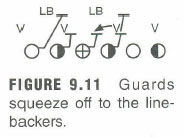 The center must always be alert for the pinch. He always anticipates this and is ready to double to the play-side linebacker (figure 9.11). The backside guard has to execute a cutoff block as the defensive lineman loops outside. The guard should squeeze off to the linebacker.
The center must always be alert for the pinch. He always anticipates this and is ready to double to the play-side linebacker (figure 9.11). The backside guard has to execute a cutoff block as the defensive lineman loops outside. The guard should squeeze off to the linebacker.
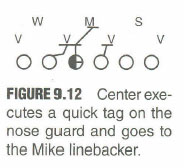 The fold block versus the even front is no more than a linebacker trap. Calls have to be made on this scheme. The play-side guard has to know that the center is no longer working the play-side A gap and that the guard is man on man with the 3-technique defender.
The fold block versus the even front is no more than a linebacker trap. Calls have to be made on this scheme. The play-side guard has to know that the center is no longer working the play-side A gap and that the guard is man on man with the 3-technique defender.
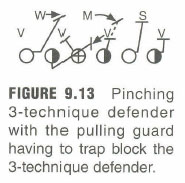 The guard must tight reach and rip off the outside shoulder of the 3-technique defender. If the 3-technique player pinches to the inside, the guard doesn't worry. Instead, he continues to the linebacker just like on a stretch or inside zone play. The pulling or folding guard folds and reads the inside half of the 3-technique player on his way to the linebacker. If the 3-technique player widens, the guard goes up and blocks the linebacker. If the 3-technique player pinches, the guard trap blocks him inside out, and the tailback needs to hit it real tight.
The guard must tight reach and rip off the outside shoulder of the 3-technique defender. If the 3-technique player pinches to the inside, the guard doesn't worry. Instead, he continues to the linebacker just like on a stretch or inside zone play. The pulling or folding guard folds and reads the inside half of the 3-technique player on his way to the linebacker. If the 3-technique player widens, the guard goes up and blocks the linebacker. If the 3-technique player pinches, the guard trap blocks him inside out, and the tailback needs to hit it real tight.



